Helmets are an essential piece of protective equipment for riding a bike. Most of us know that all bike helmets must comply with certain safety standards. But what are those standards? And what does a helmet need to pass through before it is considered safe? In this article, we have discussed in detail the different cycling helmet safety standards. Currently, the most commonly used safety standards are CPSC, EN 1078, ASTM, Snell, and AS/NZS 2063.
Commonly found helmet safety standards
There are many different standards for bike helmets around the world, each one regulated by a different authority/institution. All of these standards have been developed according to the requirements and laws of their respective regions. The following standards are the most widely used around the world, and it is a good idea to get familiar with them.
CPSC
This is the standard set by the Consumer Product Safety Commission (CPSC) and all helmets sold in the United States are required by law to meet its requirements. Prior to its establishment in 1999, other popular standards were used such as ANSI, Snell, etc. However, they all had different testing criteria and it was not actually mandatory for helmets to conform to these standards. Now customers have a common standard that they can rely on. Testing is not carried out by the government, rather manufacturers and third-party facilities perform the tests according to certain guidelines. CPSC certification is also accepted in countries all over the world including Canada, Japan, China, Taiwan, and Brazil.
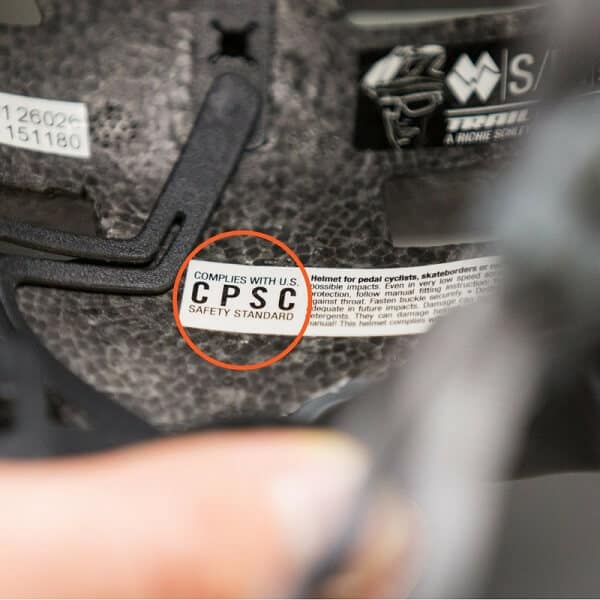
CPSC sticker | Credit: livetoplaysports.com
EN 1078, EN 1080
The EN 1078 standard for bike helmets was created by the European Committee for Standardization (CEN). This standard also applies to roller skating and skateboarding helmets. Helmets sold in 32 European nations have to have a CE certification sticker with an EN 1078 labeling along with it. EN 1080 is a separate standard created for children’s helmets and is identical to EN 1078, except for the buckling system which has a lower risk of strangulation.
The requirements of EN 1078 are somewhat less demanding than the other standards we have mentioned. However, this does not mean that EN 1078 helmets are unsafe. In the real world, there is no real difference between the number of head injuries from cyclists wearing EN 1078 helmets and CPSC helmets. Just like with CPSC, testing for EN 1078 is done either by the brands themselves or by an accredited lab.
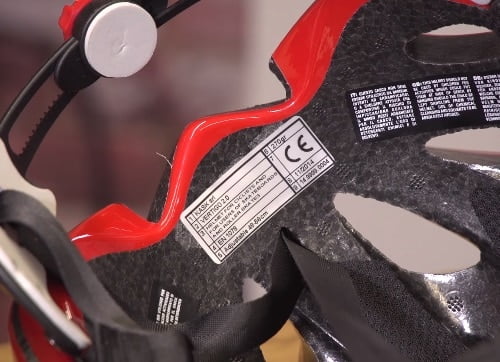
CE EN 1078 sticker
ASTM F1447, F2032, F1952
ASTM International (formerly “American Society for Testing and Materials”) is one of the oldest standards organizations in the world. In the late 20th century, more than half of all helmets around the world had an ASTM certification. The ASTM F1447 certification for bike helmets is the basis upon which the CPSC certification was created, so they are both very similar.
The ASTM F2032 standard was made for BMX helmets which makes them able to withstand stronger impacts. ASTM’s most demanding standard is the F1952. This is a voluntary standard that was designed for downhill mountain biking helmets. However, it is not required for the helmet to be a full-face helmet. For ones that are full face, there is an additional chin bar test.
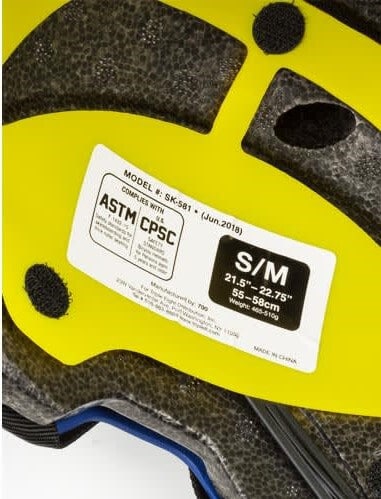
Helmet with ASTM and CPSC sticker | Credit: consumerreports.org
Snell B-90, B-95
The Snell Memorial Foundation is another organization that has been creating standards for helmets for a long time. Both their B-90 and B-95 standard for bicycle helmets are known for being tougher than other safety standards, especially B-95. In fact, only the ASTM F1952 standard passes helmets of a similar sturdiness. The Snell standard requires testing for much higher impact energies than usual. So, are Snell certified helmets the best? Not really. The more impact protection a helmet has, the bulkier it will be which makes it slightly uncomfortable. Besides, the B-90 and B-95 standards are voluntary and most helmets available are not able to meet the requirements.

Snell B95 sticker | Credit: https://smf.org/cert
AS/NZS 2063
In Australia, the most prominent standards development body is Standards Australia. Working along with the New Zealand national standards organization, Standards New Zealand, they have developed the AS/NZS 2063 certification for bike helmets. These are the most up-to-date standards having been updated in 2020. In some aspects, the requirements of the AS/NZS 2063 is superior to the CPSC standard.
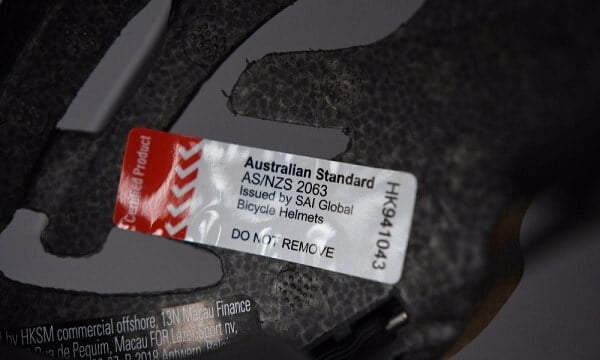
AS NZS 2063 sticker | Credit: bikeexchange.com.au
Criteria for meeting safety standards
Multiple aspects of bike helmets are tested to ensure that they meet safety standards. The criteria must be met before a helmet is certified.
- The helmet should have a solid construction and be able to stay on your head. Additionally, it should be ventilated, lightweight, easy to take off, and compatible with glasses.
- The materials used should be non-reactive to sweat, skin, or cosmetics. They should also be non-toxic.
- The helmet should allow the user to have a reasonably good field of vision.
- It should have adequate shock absorption properties and must be able to protect your head from all sides.
- The side straps and chin straps should not break or get too stretched out during a crash.
How bike helmets are tested
Most of the reputed standards in the world follow similar testing in the lab. The exact conditions and values may be different. But in general, the same steps are followed.
- First of all, the test area is outlined. This determines which parts of the helmet need to be tested for impacts. Each standard might have a slightly different outline which is stated down to the millimeter.
- Next, the helmets are conditioned. Multiple helmets of the same model are used. Each is tested at different temperatures and moisture levels. Some are even artificially aged using chemicals.
- Then the helmet is fastened to a head form and a strong rotational force is exerted on it using a string with a weight attached at one end. The other end is tied to the helmet. This tests the helmet’s positional stability.
- The straps of the helmet are then tested. A similar method to the previous step is used. In this test, the straps should not break or stretch beyond a certain value.
- This is the most obvious test, the impact test. The helmet is again attached to a head form and this time it is dropped from a certain height onto an anvil. The anvil may be flat, round, or in another suitable shape. An accelerometer in the head form measures the g-forces transferred to the head which must not cross a specified value.
- Another similar test involves a spike-shaped anvil. Here, the puncture resistance of the helmet’s outer shell is tested. If the spike penetrates and touches the head form, the helmet is failed.
- The final test is only done if the helmet has a chin bar. A weight is dropped on the chin bar. The helmet will fail if this part breaks or deforms beyond a specific value.
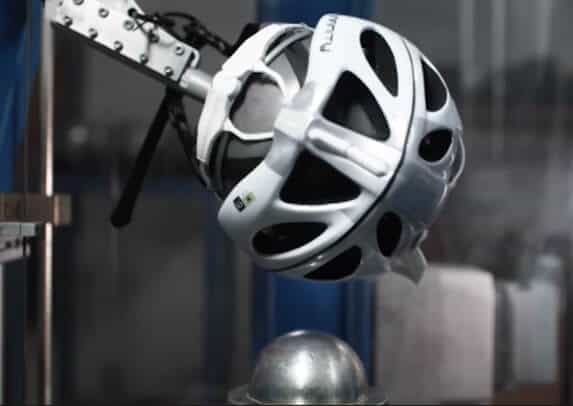
Helmet falling on the anvil
Marking/labeling requirements
Once a helmet passes the tests of any standard, it can be labeled with an appropriate marking or sticker. Even, the labeling must follow certain instructions. For example, the EN 1078 marking should contain a warning that the helmet cannot be used for certain activities like climbing. Other things might also be present, as the CPSC requirement for having an illustration for how the helmet should be properly positioned.
Additional safety technology in bike helmets
Other than the safety standards that a helmet must legally meet, there are additional features incorporated in modern helmets that make them even safer. The most popular technology found in plenty of helmets these days is MIPS. It stands for Multi-directional Impact Protection System, and as you can tell, it absorbs the energy from rotational forces by allowing the helmet to slide independently of the head. Similar technologies, such as SPIN (Shearing Pads INside) and WaveCel are also available.
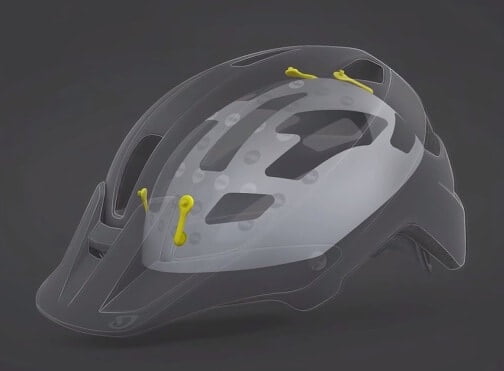
MIPS layer
Frequently Asked Questions
Q1. Can I use a CE certified helmet in the US?
Ans.: While a CE EN 1078 certified helmet is safe to use, such a helmet cannot be legally sold for use in the United States. A CPSC certification is mandatory by law. The same is true for every nation – helmets sold in a country must follow the guidelines set by their government. So, it’s not like you cannot use a CE certified helmet in the US, rather you won’t be able to find one for sale.
Q2. What is a bike helmet made of?
Ans.: Nearly all bike helmets are made of the same set of materials. The outer shell is made of polycarbonate and its main function is to allow the helmet to slide over surfaces to protect the neck. Underneath that, there is the Expanded Polystyrene (EPS) foam lining. The EPS foam is the main protector that absorbs the brunt of the force from a crash. Keep in mind that the foam is only effective once and the helmet needs to be replaced after a crash.
Next, we have the retention system which is usually in the form of a rear dial. Turning this dial tightens or loosens the helmet. Then there are the straps and buckles that further secure the helmet on the head. Finally, there is the inner padding which is mostly used for comfort and sweat absorption. Some helmets have additional components such as a MIPS layer.
Q3. Can I use a bike helmet for other activities?
Ans.: That depends on what the other activities are. You can use a bike helmet for skateboarding, roller skating, ice skating, and scooter riding. However, other activities require a much sturdier helmet and so a bike helmet would not be safe enough. Examples of such activities include skiing, rock/wall climbing, go-karting, etc. In conclusion, it is strongly recommended that you use a helmet according to what it was designed for.
➥ You should definitely check this out if you’re wondering, what’s the difference between bike & ski helmets.
Q4. Is it safe to use a helmet without any safety certification?
Ans.: It is definitely not recommended. You can’t say for sure that a helmet without a standard label is completely unsafe to use. But you can’t be sure that it is 100% safe either. So, better not to use it. Be sure to check for the appropriate safety standards before buying a helmet. If you ever find a seller that sells helmets without a marking, you should report them to the authorities.
Conclusion
Even though a bike helmet is not required by law in most places, you should always wear one. And that helmet should comply with an official safety standard. We have provided you with all the information about the most common safety standards. Hopefully, now you will be able to identify them when shopping for a new helmet.
